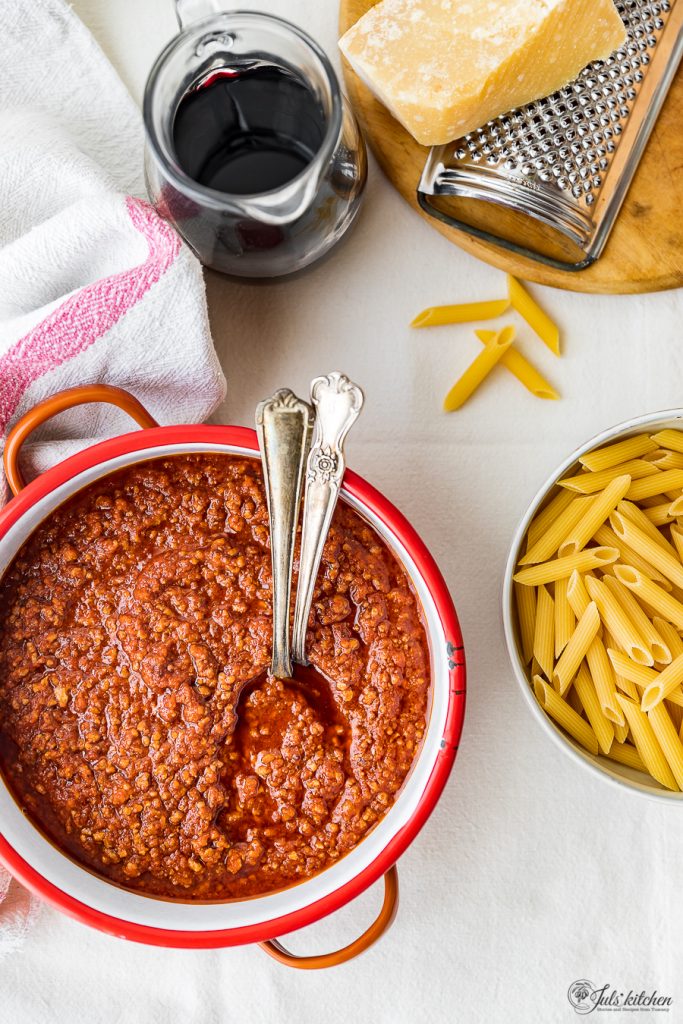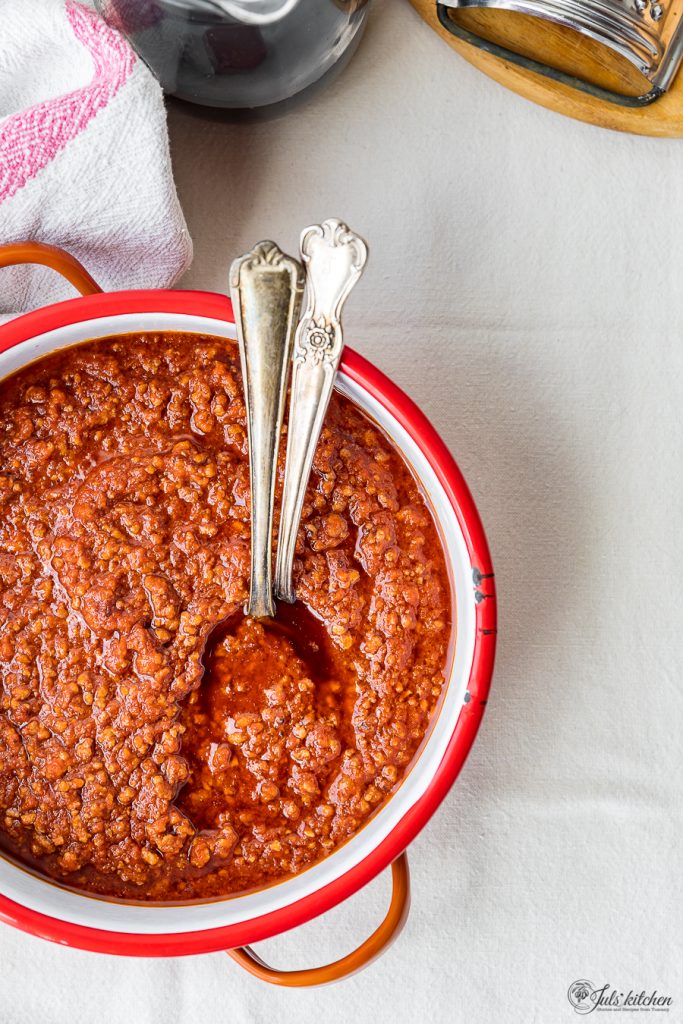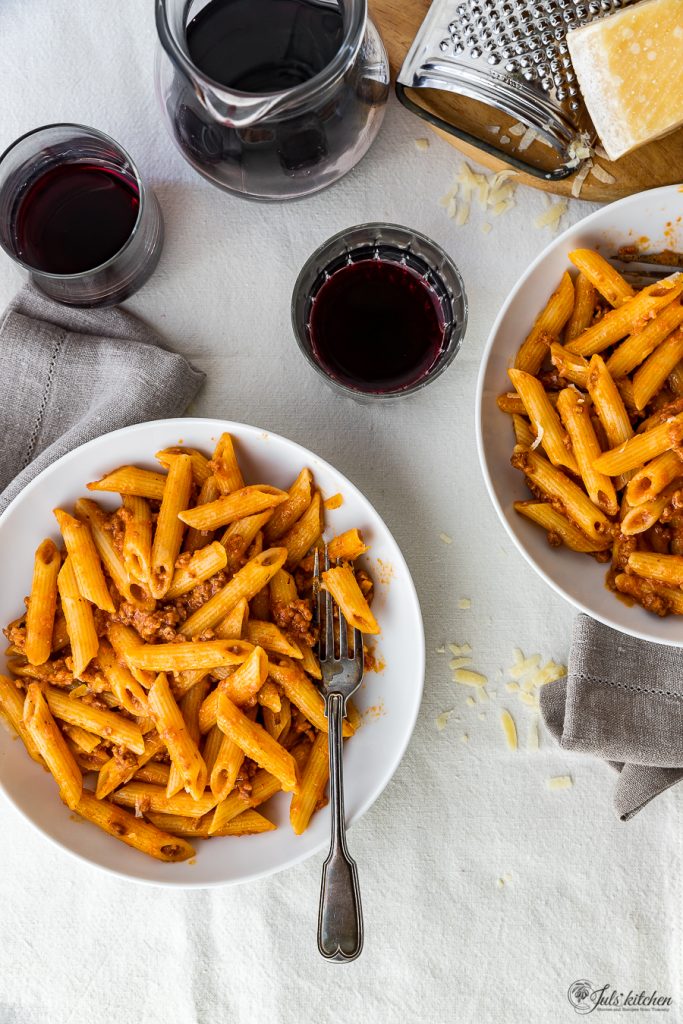My Tuscan ragù and the Florentine penne strascicate
How many meat sauces exist in Italy? In between the rich and self-indulgent Bolognese ragù, where the ground beef and the ground pork are cooked with white wine, milk and tomato paste, and the Neapolitan one, where tradition has it that there is no ground meat, but whole pieces of meat that must be cooked slowly in a rich tomato sauce, there is a glimpse of irreverence and local rivalry, of anarchy and tradition, where the Tuscan ragù is slowly simmered at home.
My Tuscan ragù
I have already talked about my family Tuscan ragù here on the blog, about my grandma’s modern version – consider that my grandma and her recipe for ragù are the same age – and about the rich battuto, the finely chopped vegetables, that is her secret.
Today I would like to talk about my family Tuscan ragù with more details, as it is time to add it to my cooking repertoire. If we want to be true to the tradition, though, rather than ragù, here in Tuscany we call it sugo di carne, meat sauce.
It’s always handy to have a traditional sugo di carne in your cooking repertoire.
Two years ago I decided to share these recipes, staples of a Tuscan repertoire, analysing the ingredients and the process with plenty of details so that, if you want, you’ll be able to include them into your collection and make Tuscan cooking your signature style.
After the crespelle alla fiorentina and the eggplant meatballs, after the ricotta and kale gnudi, after one of the desserts you loved the most, a humble Tuscan apple olive oil cake, and the summer baked eggplants with a breadcrumb topping, I want to share with you the Tuscan ragù.
I’m not scared by recipes that require a long cooking, they are always more forgiving, especially for beginners.
Take the carbonara, for example: it is much more likely to miss by a whisker that precise balance in between temperature, pecorino, pancetta and wrist movement, which makes the egg velvety and creamy, than you can inadvertently overcook the ragù.
Arm yourself with patience, time – you’re not required to spend the whole morning watching the pot simmering on the stove, even though I suppose there are worse pastimes – and good ingredients: this will become one of your go-to sauces for pasta. Make a big batch, as in today’s recipe, use some of it for a bowl of tagliatelle, some for a lasagna and freeze what is left in small portions.
These days are made for ragù: it’s cold outside, the windows in your kitchen will quickly be fogged up by the pot muttering on the stove and smell of ragù, that delicious timeless heartwarming smell, will stick to your clothes as the warmth of your grandma’s hug.

Let’t talk about the ingredients to make a Tuscan ragù
The battuto – the finely chopped carrot, celery, red onion, but sometimes also parsley, garlic or leeks – is the backbone of this meat sauce, sautéed over low heat and then stirred into the ground meat. It is also one of the best kept secrets of my grandmother, her ragù rich with vegetables and flavour.
As for meat, traditionally at home we use both lean minced beef and minced pork. Sometimes we replace the ground pork with the same weight of fresh pork sausages. The ragù will be tastier but slightly fatter. Finely mince a thick slice of Tuscan prosciutto or spalla (the cured shoulder of the pork) and add it to the ground meat for an old fashioned, robust sauce. Opt instead for chicken livers – or rabbit livers, as my great-grandmother used to do – for a rich sauce typical of the countryside, where the courtyard animals were more common than beef and pork.
You must cook the Tuscan ragù with red wine – pour it in little by little -, and with tomato purée (just tomatoes that have been peeled and blended into a sauce), even better if it is your home made tomato purée, made during the heat of summer. To give more character to the ragù and have a more rustic sauce, sometimes I prefer to replace the passata with the same weight of peeled tomatoes, roughly crushed with my hands. Do you want to know another of my grandma’s secrets? Two large tablespoons of tomato paste.
Tuscan ragù
Ingredients
- 1 red onion
- 2 carrots
- 3 stalks of celery
- 1 small bunch of parsley
- 4 tablespoons of extra virgin olive oil
- 300 g (2/3 lb) of minced pork meat
- 500 g (1 1/8 lb) of minced beef meat
- salt
- Freshly ground black pepper
- 200 ml (3/4 cup) of red wine
- 1,5 l (6 1/3 cup) of tomato purée
- 2 tablespoons of tomato paste
Instructions
- Finely chop the carrots, celery, parsley and onion. Use a good sharp knife, and reduce the vegetables in a fine mince. We call this battuto in Italy, while the French call it mirepoix. If you prefer to use a food processor - even my grandma has abandoned her cutting board and mezzaluna for a vegetable chopper - do it in several times. First chop the celery, parsley and carrot, then the onion, just enough to finely shred it. Careful not to reduce the onion in a mush.
- Cover the bottom of a pot with extra virgin olive oil. Add the finely chopped vegetables. Add also a generous pinch of salt: this will help you to cook the vegetables without burning them, as the salt will extract the moisture from the vegetables.
- Cook over a low heat for about ten minutes, stirring often. The battuto will be happily sizzling, do not burn it or darken it too much. Now that the battuto is stir fried in the olive oil, we call it a soffritto.
- Move the pot over medium heat and add the ground beef and pork. Stir with a wooden spoon to break the meat into smaller pieces and mix it into the soffritto. Stir continuously and scrape the ground meat from the bottom and the sides of the pot with a wooden spoon. It will take at least 20 minutes to get to the right cooking point. The meat will release some liquid, so brown it until the liquid has been completely absorbed, and the meat is nicely browned. Now season with salt and pepper.
- Now add the red wine gradually, and reduce it: pour the red wine in at least three times, reducing it completely before pouring more. Doing this, the wine will flavour the meat, without boiling it.
- Now add the tomato purée and the tomato paste, stirring thoroughly. The ragù will begin to mutter. Cover the pot, and simmer slowly.
- Stir from time to time, cooking it for at least an hour and a half, even two hours. The ragù will be ready when you will notice on the surface of the meat sauce puddles of olive oil, now red for the long cooking with the tomato sauce. Keep cooking until you do spot them.

The Florentine penne strascicate
Penne strascicate col sugo di carne is a classic Florentine dish that you often find in local trattorias, along with pappa al pomodoro, ribollita, or beans with olive oil. The penne is the shape of pasta that is almost exclusively used. I prefer the ridged ones, but in Florence they often use the smooth penne: this is one of the very few typical Tuscan dishes based on dry pasta, perhaps the only one.
At the beginning they would use leftover pasta, which needed the heat of a scorching pan and the rich flavour of the ragù to become appetising again. Nowadays, to make this recipe, I cook the penne very al dente, drain them, leaving aside some of the cooking water and toss them in a pan with the meat sauce, a few tablespoons of olive oil, a handful of grated Parmigiano Reggiano and some pasta water. This is when you have to strascicare the penne, which means to drag them in the pan, to toss them, so that they finish to cook in the sauce, absorbing the flavour. Can you imagine them?

More recipes to make your own ragù
Do you have a go-to recipe to make ragù? Does it belong to a specific tradition, or does it distance from it with pride? Has it been handed down in your family from generation to generation?
I’m quite obsessed with ragù, so here on the blog you can find many a recipe, with different ingredients, cooking methods and origins.
Cinta Senese Ragù. The pork shoulder and the sausages became instead a rustic meat sauce, enriched by those herbs and spices which are typical aromas in this rural area, bay leaves and juniper, also suitable for game, which are well matched to the intense flavour of the cinta senese meat. Cook the sauce on low heat, mix it with patience and love with a wooden spoon, and use tomato sauce and red wine, a Chianti of course, to remain in the same area.
White pork ragù. I used scamerita, pork neck, which I finely minced, as a base. A generous amount of vegetables, as this is grandmothers’ wisdom, or at least, of my nonna: you can get a rich meat sauce only if it starts with an abundant battutto. Without tomato, the acidic note comes from white wine, poured in little by little to cook the meat. I checked the flavour several times, gradually adjusting the salt. Finally, the Parmigiano Reggiano, generously grated over the tagliatelle, gives the dish a further note of acidity and savouriness.
Vegetarian options
Sage and almond ragù. They call it a ragout, though it is as quick to make it as boiling your pasta, even quicker. It won’t require you to cook this sauce for hours as in my grandma’s ragù. It’s not even a pesto, as you won’t need to blend almonds and sage into a smooth sauce as you would do with basil and pine nuts for the classic pesto Genovese, or with my pistachio pesto, or the Tuscan kale pesto, or even a fresh pea pesto. This is just the most essential three ingredient sauce for your pasta. You’ll need almonds, better if unpeeled, as this will add colour to your sauce, fresh sage for an aromatic note and your best extra virgin olive oil.
Vegetarian lentil ragu. Thie ragu is a vegetarian sauce for pasta which won’t make you miss meat: there are lentils, the backbone of the sauce, an abundant amount of finely chopped vegetables, which is the secret of my grandmother’s classic ragout, the butternut squash, which melts into a cream, giving colour and flavour to the sauce along with a generous spoon of tomato paste, and dried porcini mushrooms, which add a depth of taste, an instant reason to celebrate.
White meat options
Guinea fowl ragù. For the ragù, take your time, collect herbs and patience and you’ll be rewarded with a rustic meat sauce that perfectly represents the peasant cooking of the Tuscan countryside. Not beef nor pork, but poultry, vegetables and time are the essential ingredients here.
Rabbit ragù. I call it a ragù, a meat sauce, even though it is made without tomato sauce and with a meat which is typically eaten pot roasted, fried or even alla cacciatora, with meaty black olives. Rabbit is a common courtyard animal for families in Tuscany, a meat which we usually cook almost on a weekly base, and even for children, for their first attempts at eating solid food. It makes a tasty, white meat sauce for a Sunday meal, an alternative ragù with the zing of lemon zest and the richness of lardo.
Quick options
Sausage ragù. The sausage ragù is a quick and clever alternative to the classic meat sauce you would make on a Sunday. It requires half the cooking time of a meat sauce made following all the rules, but it will bring in your dish all the richness and flavour of an timeless dish. The homemade gnocchi, made with potato starch instead of flour, are naturally gluten-free, a soft pillow on which to rest dreams and spoonfuls of sausage ragù.

Serve the Tuscan ragù with…
A bowl of pasta generously dressed with this Tuscan ragù calls for Sunday traditions, a table set with a freshly ironed tablecloth, the sun flooding your house through the window, filtered by a crochet curtain. I would build a traditional yet unpretentious menù around the penne strascicate, something that everyone would love, something that would make us feel like a family.
- Pork roast with herbs. I crushed in a mortar all the dried herbs that I would have used along with calamint, savory and Siena tarragon, I added a few grains of black pepper and a few juniper berries to disguise a simple pork loin with game scents. It’s amazing how some dried herbs and a few juniper berries can turn one of the usual Sunday meat dishes into a roast worth of a medieval castle, juicy and flavourful, with a slight hint of wood and resin.
- Stewed artichokes. Artichokes should be prepared with a good dose of patience, as you are supposed to clean them, removing all the tough outer leaves, and open them by hand, like a rose. Then you stuff the artichokes with a battuto made of garlic, parsley, salt, black pepper and carnesecca, as you read in the old books of Tuscan cuisine.
- Zuppa inglese. Zuppa inglese means literally English soup and basically it is a trifle, which was made when there was sponge cake or some savoiardi, lady biscuits, an acclaimed afternoon snack, perfect for those days when you needed a boost of energy or an extra cuddle. Layers of custard and chocolate custard with savoiardi soaked in alchermes: zuppa inglese is one of the most traditional desserts.
A Tuscan ragù in your cooking repertoire
After reading Cooking for Mr. Latte, by Amanda Hesser, I fell in love with the concept of having a cooking repertoire, and I decided to share here on the blog these recipes, staples of a Tuscan repertoire, analysing the ingredients and the process with plenty of details so that, if you want, you’ll be able to include them into your collection and make Tuscan cooking your signature style.
I chose these recipes not to impress, but to nourish, and because, using Amanda Hesser’s words, they would express my true sensibility as a cook, not my ambition.
All the recipes of my cooking repertoire
These are all the recipes I added so far into my cooking repertoire. This is an ever growing list, an always expanding collection which represents the way I live Tuscan food and cooking. Have you already tried something?
- Crespelle alla fiorentina. It is a handy recipe to learn as you can vary the filling according to the season: asparagus, artichokes and butternut squash are some of my favourites along with spinach and Swiss chard. You can mix the vegetables with fresh milky ricotta or add some béchamel into the filling. Cheese is a welcomed ingredient: Parmigiano Reggiano, Tuscan or Roman Pecorino, ricotta salata, or any other savoury aged cheese that you would happily grate over your pasta.
- Ricotta and Tuscan kale gnudi. There are two crucial ingredients here which can help you ease the anxiety while waiting for your gnudi to float tot the top: ricotta and cavolo nero, the Tuscan kale. Use a well-drained ricotta and squeeze very well the cooked kale. Once you make this, they will be your next success in the kitchen.
- Beef and eggplant meatballs. According to the season, you can substitute roasted eggplants with boiled potatoes, roasted butternut squash or breadcrumbs soaked in milk. I usually choose between grated Parmigiano Reggiano, aged Pecorino or Provolone to add flavour to the meat, sometimes adding brined capers, too. This time I opted for Parmigiano, along with a pinch of dry oregano to give a mediterranean touch.
Main courses and side dishes
- Stuffed turkey breast. One of the recipes that my mum taught me and that I immediately associate with Sunday lunches is the stuffed turkey breast, roasted on the stovetop and not in the oven. It is a humble dish, but it has an enormous potential.
- Baked eggplants. Colours and textures of that once loved recipe surfaced along with the ingredients: eggplants of course, either the round purple ones or those thin long ones, then breadcrumbs, parsley, capers, garlic and some grated Parmigiano. There it was, my forgiving recipe, thick slices of eggplants topped with boldly flavoured breadcrumbs, roasted in the oven until golden and crisp.
- Italian potato salad. So a potato salad, which I had overlooked for years, becomes a distinguishing element of a menu, especially if you dress it with an Italian twist, with wild fennel, capers and olives. You can find the same aromas in a roasted pork loin with olive oil and wine, or in the baked eggplants that you are planing to serve as an appetiser.
Desserts
- Apple olive oil cake. You can dress it up for a dinner party: serve a slice of warm apple cake with a scoop of vanilla gelato, a cloud of whipped cream or a drizzle of custard. Wrap in foil a slice of cake for a school break or an office break. Bake the olive oil apple cake on a Sunday and enjoy it for breakfast on the first days of the week with a strong coffee or a cappuccino.
- Coffee and vanilla pound cake. A versatile recipe to make a pound cake with the ingredients you have at hand, with a detailed explanation of the four macro categories of ingredients you can use, plus a recipe for a vanilla pound cake marbled with coffee, designed to wake you up in the morning. Use white farro flour, white sugar and dark cane sugar, Greek yogurt and butter.
- Ricotta crumb cake. I still have to decide if I prefer the cake warm from the oven, or after a few hours of fridge. This ricotta crumb cake is an unmissable summer cake, and I’ll let you decide when to serve it, if you are in hurry or armed by adamant patience.
Link Love
- Learn more about odori, battuto and soffritto here, or listen to the second episode of our podcast, where I explain how important these tree words are for Italian cooking.
- The pasta shape dictionary: you can explore all the different shapes of Italian pasta on this website, learn about their origins and which sauce or cooking method is better for them.
- More about penne lisce (smooth)? Here you learn why Martelli, one of the most famous pasta producers in Tuscany, just have penne lisce.






Mine is exactly the same as yours and sometimes I add a few anchovies to the base of the sauce. However I mostly leave out the carrot and celery as the kids prefer it that way
Thank you! My husband and I made it and we will definitely be adding it to our rotation! So good!
Thank you Holly for the feedback, this makes me so so happy!
So delicious Giulia! I made the Tuscan Ragu for my family and it brought smiles to all of our faces and happiness to our bellies. Thank you for sharing the recipe!
Thank you Melinda, this is such a sweet thing to say, it makes me so happy!
Can you clarify Step 7? Do I want to see the puddles of red oil or not. Thank you!
Hi Lynne, yes, you want to see those puddles!
Wow, this post has me craving Italian food like no other! Can’t wait to try making your Tuscan ragù and Florentine penne strascicate at home. Your step-by-step instructions are so clear and easy to follow. Thanks for sharing this recipe with us!
thank you!